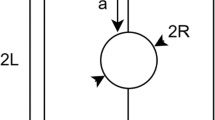Abstract
For many fracture problems of practical engineering importance, the three-dimensional effects are significant and a three-dimensional analysis for the problems is thus required. In this paper, an endochronic theory coupled with anisotropic damage is first established, which is actually an elasto-plastic damage theory coupled with isotropic-nonlinear kinematic hardening. The ductile damage evolution equation is derived from the orthogonality rule with a new intrinsic time scale introduced especially for damage evolution. Then, a three-dimensional finite element program incorporating the endochronic damage model is formulated and emploved to analyze the widely used CT fracture specimen. Two failure criteria are proposed for the prediction of crack initiation direction and crack initiation load. From the analysis, significant three-dimensional effects are observed and the crack is estimated to initiate first at the middle of the crack front line. Experiments have been conducted to verify the proposed theory and the results are found to compare well with the theoretical values.
Similar content being viewed by others
References
J.R. Rice, Journal of Applied Mechanics, Transactions of ASME (1968) 379–386.
J.W. Hutchinson, Journal of the Mechanics and Physics of Solids 16 (1968) 13–31.
J.R. Rice and G.F. Rosengren, Journal of the Mechanics and Physics of Solids 16 (1968) 1–12.
J.A. Begley and J.D. Landes, in Fracture Toughness, Proceedings of the 1971 National Symposium on Fracture Mechanics, Part II, ASTM STP 514 (1972) 1–20.
J.D. Landes and J.A. Begley, in Fracture Analysis Proceedings of the 1973 National Symposium on Fracture Mechanics, Part II, ASTM 560 (1974) 170–185.
K.B. Broberg, Journal of the Mechanics and Physics of Solids 19 (1971) 407–418.
D. Siegele and W. Schmitt, Computers and Structures 17, 5/6 (1983) 697–703.
D. Siegele, Computers and Structures 32, 3/4 (1989) 639–645.
N.P. O'Dowd and C.F. Shih, Journal of the Mechanics and Physics of Solids 39, 8 (1991) 898–1015.
N.P. O'Dowd and C.F. Shih, Journal of the Mechanics and Physics of Solids 40, 5 (1992) 939–963.
F.A. McClintock, Journal of Applied Mechanics, Transactions of ASME (1968) 363–371.
C.L. Chow and J. Wang, Engineering Fracture Mechanics 30 (1988) 547–563.
C.L. Chow, Engineering Fracture Mechanics 33 (1989) 309–317.
C.L. Chow and X.F. Chen, International Journal of Fracture 60 (1993) 49–63.
K.C. Valanis, Arch. Mech. 23 (1971) 517–533.
K.C. Valanis, Arch. Mech. 23 (1971) 535–551.
K.C. Valanis, International Journal of Nonlinear Mechanics 6 (1971) 337–360.
R.S. Rivlin and J.L. Erickson, Journal of Rational Mechanics and Analysis 4 (1955) 323–425.
J.R. Rice and D.M. Tracey, Journal of the Mechanics and Physics of Solids 17 (1969) 201–217.
H. Ziegler, An Introduction to Thermomechanics, North-Holland, Series in Applied Mathematics and Mechanics (1977) Chapter 14.
C.L. Chow and X.F. Chen, International Journal of Fracture 55 (1992) 115–130.
Author information
Authors and Affiliations
Rights and permissions
About this article
Cite this article
Chow, C.L., Chen, X.F. Three-dimensional fracture analysis of CT specimens with a ductile damage model based on endochronic plasticity theory. Int J Fract 69, 229–249 (1994). https://doi.org/10.1007/BF00034764
Received:
Accepted:
Issue Date:
DOI: https://doi.org/10.1007/BF00034764




